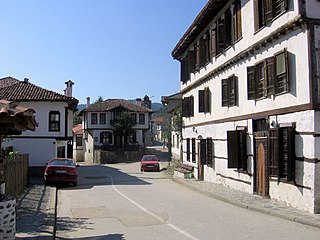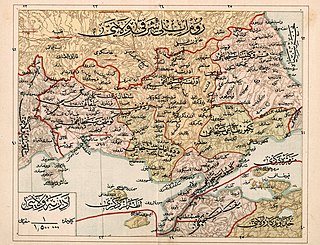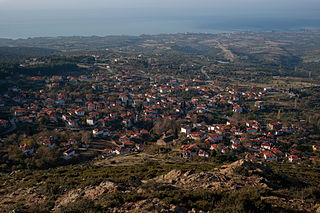
Xanthi is a city in Thrace, northeastern Greece. It is the capital of the Xanthi regional unit of the region of East Macedonia and Thrace.

Zlatograd is a town in Smolyan Province, Southern-central Bulgaria. It is the administrative centre of the homonymous Zlatograd Municipality. In December 2009, the town had a population of 7,110.

Ardino is a town in southern Bulgaria, in the Rhodope Mountains. It is located in Kardzhali Province and it is also close to Smolyan.

The Bulgarian Exarchate was the official name of the Bulgarian Orthodox Church before its autocephaly was recognized by the Ecumenical See in 1945 and the Bulgarian Patriarchate was restored in 1953.

The Vilayet of Kosovo was a first-level administrative division (vilayet) of the Ottoman Empire in the Balkan Peninsula which included the current territory of Kosovo and the western part of the Republic of North Macedonia. The areas today comprising Sandžak (Raška) region of Serbia and Montenegro, although de jure under Ottoman control, were in fact under Austro- Hungarian occupation from 1878 until 1909, as provided under Article 25 of the Treaty of Berlin. Uskub (Skopje) functioned as the capital of the province and the mid way point between Istanbul and its European provinces. Uskub's population of 32,000 made it the largest city in the province, followed by Prizren, also numbering at 30,000.

The Vilayet of Erzerum was a first-level administrative division (vilayet) of the Ottoman Empire.

The Vilayet of Manastir was a first-level administrative division (vilayet) of the Ottoman Empire, created in 1874, dissolved in 1877 and re-established in 1879. The vilayet was occupied during the First Balkan War in 1912 and divided between the Kingdom of Greece and the Kingdom of Serbia, with some parts later becoming part of the newly established Principality of Albania.

The Vilayet of Salonica was a first-level administrative division (vilayet) of the Ottoman Empire from 1867 to 1912. In the late 19th century it reportedly had an area of 12,950 square miles (33,500 km2).
This article is about the demographics of the Ottoman Empire, including population density, ethnicity, education level, religious affiliations and other aspects of the population.
Vardar Macedonia, the area that now makes up the Republic of North Macedonia, was part of the Ottoman Empire for over five hundred years, from the mid-14th century to 1912. However, the Ottomans themselves did not keep any "Macedonia" as an administrative unit. Instead Vardar Macedonia was part of the Ottoman province or Eyalet of Rumelia. The name Rumelia means "Land of the Romans" in Turkish, referring to the lands conquered by the Ottoman Turks from the Byzantine Empire.

The Vilayet of Janina, Yanya or Ioannina was a first-level administrative division (vilayet) of the Ottoman Empire, established in 1867. In the late 19th century it reportedly had an area of 18,320 square miles (47,400 km2). It was created by merging Pashalik of Yanina and Pashalik of Berat with sanjaks of Janina, Berat, Ergiri, Preveze, Tırhala and Kesriye. Kesriye was later demoted to kaza and bounded to Monastir Vilayet and Tırhala was given to Greece in 1881.

The Eyalet of Adrianople or Edirne or Çirmen was constituted from parts of the eyalets of Silistra and Rumelia in 1826.
The Vilayets of the Ottoman Empire were the first-order administrative division, or provinces, of the later empire, introduced with the promulgation of the Vilayet Law of 21 January 1867. The reform was part of the ongoing administrative reforms that were being enacted throughout the empire, and enshrined in the Imperial Edict of 1856. The reform was at first implemented experimentally in the Danube Vilayet, specially formed in 1864 and headed by the leading reformist Midhat Pasha. The reform was gradually implemented, and not until 1884 was it applied to the entirety of the Empire's provinces.

The Sanjak of Prizren was one of the sanjaks in the Ottoman Empire with Prizren as its administrative centre. It was founded immediately after Ottoman Empire captured Prizren from Serbian Despotate in 1455. The rest of the territory of Serbian Despotate was conquered after the fall of Smederevo in 1459, and divided into following sanjaks: Sanjak of Vučitrn, Sanjak of Kruševac and Sanjak of Smederevo. At the beginning of the First Balkan War in 1912, the territory of Sanjak of Prizren was occupied by the armies of Kingdom of Serbia and Kingdom of Montenegro. Based on Treaty of London signed on May 30, 1913, the territory of Sanjak of Prizren was divided between Serbia and Montenegro.
The Sanjak of Sofia was one of the sanjaks of the Ottoman Empire which county town was Sofia. It was founded in 1393 and disestablished after the creation of the Principality of Bulgaria in 1878.

The Sanjak of Dedeağaç, originally in 1878–1884 the Sanjak of Dimetoka, was a second-level province (sanjak) of the Ottoman Empire in Thrace, forming part of the Adrianople Vilayet. Its capital was Dedeağaç, modern Alexandroupoli in Greece.

The Sanjak of Gelibolu or Gallipoli was a second-level Ottoman province encompassing the Gallipoli Peninsula and a portion of southern Thrace. Gelibolu was the first Ottoman province in Europe, and for over a century the main base of the Ottoman Navy. Thereafter, and until the 18th century, it served as the seat of the Kapudan Pasha and capital of the Eyalet of the Archipelago.

The Sanjak of Siroz or Serres was a second-level Ottoman province encompassing the region around the town of Serres in central Macedonia.























